In the lead-up to the fast-approaching and busy holiday season, we’ve been carefully analyzing customer data, as we do each year, to help businesses better prepare for the coming onslaught of fraud. Driven by heightened consumer activity, fraudsters continued to capitalize on the surge in online transactions, leveraging sophisticated tactics to exploit vulnerabilities in high-traffic sectors like ecommerce, iGaming and fintech.
By studying the trends and spikes in fraud volume, specifically from November and December, we can identify patterns, uncover emerging risks and arm businesses with actionable strategies to mitigate these threats effectively. Understanding how fraud evolved last holiday season provides critical insights to help companies stay ahead as they prepare for the year’s most challenging and lucrative period.
A Rise in Fraud Volume & Sophistication
Fraudulent activity surged across industries in the last quarter of 2023. Over 8.92 million fraudulent transactions were flagged and blocked by SEON, with iGaming (3.89 million) and Buy Now Pay Later (1.75 million) sectors leading the way. The average fraud percentage peaked at 12.27% on December 18, underscoring the need for heightened vigilance during this period.

Key Drivers of Increased Fraud:
- Holiday Traffic Surge: The holiday season brought a spike in online transactions, giving fraudsters more opportunities to exploit vulnerabilities.
- Advanced Fraud Techniques: Privacy tools such as VPNs and proxy servers rose, with VPN usage peaking at 5.02% on December 18, marking a 50% increase over the season’s average.
- Automation and Bots: Bot-driven fraud increased steadily, from 0.11% in early November to a holiday season high of 0.49% in December, targeting high-transaction sectors like ecommerce and financial services.
Fraud Peaks by Industry & Activity
Fraudsters were not uniform in their tactics, with industries and activity types presenting unique vulnerabilities:
- Industry Breakdown: The iGaming and Payment Gateway sectors consistently reported high fraud activity, with iGaming topping 14% on multiple occasions.
- Type of Activity: Fraud in account creation, transactions, and subscription services rose sharply, with subscription fraud increasing in December.
Key Holiday Fraud Trends
Specific days and weeks during the holiday season saw significant spikes in fraudulent activity. Perhaps surprisingly, December 25 stood out with the highest overall fraudulent activity, aligning with heightened consumer activity and the reduced vigilance typical of the holiday itself. Additionally, the week of December 18–24 marked the sharpest rise in fraud across most industries, underscoring the importance of heightened fraud prevention efforts during this critical period.
The Role of Privacy Tools
Privacy tools like suspicious browsers and VPNs played a significant role in enabling fraud during the holiday season. Privacy browser usage averaged 1.78% throughout the season but spiked noticeably on crucial holiday shopping days, illustrating how fraudsters strategically use these tools to exploit peak transaction periods.
Preparing for 2025: Lessons from the Holiday Season
The fraud trends from last year’s holiday season highlight how crucial it is to take a proactive, data-driven approach to fraud prevention. As businesses gear up for 2025, here are some key lessons to keep in mind:
- Be Ready for Seasonal Spikes: Fraud tends to rise along with consumer activity, so planning for the holiday rush is imperative.
- Embrace Automation: With bots becoming more prevalent, automated fraud detection isn’t just nice to have – it’s essential.
- Keep an Eye on Privacy Tools: Monitoring VPNs, proxies and suspicious browsers can help uncover vulnerabilities before they become more significant problems.
By acting on these insights, businesses can stay ahead of fraudsters and protect their operations during high-risk periods.
The insights and statistics shared in this article are derived from SEON’s internal data and reflect activity trends observed across our customer base during the 2023 holiday season. These findings are anonymized and aggregated to protect customer confidentiality and should be viewed as indicative of broader fraud trends rather than exhaustive or industry-wide data.







